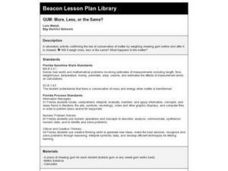Curated OER
How do You Stack Up? Revisited
Students estimate the thickness of coins. In this stack up instructional activity, students stack pennies, nickels, dimes and quarters. They calculate and record the thickness of each coin. Students stack coins and estimate the height...
Curated OER
Classroom Meteorologists: An Experiential Approach to Learning about Seasons and Weather
Students examine several concepts about weather in the seven lessons of this unit. This year long activity helps students to gather data seasonally about wind, clouds, precipitation, and temperature. Earth's three climate zones are...
Curated OER
Perplexing Perimeters
In the process of constructing their own "rulers" Students develop a sense of the size of a centimeter and meter. Students select the appropriate "ruler" for the tasks. Finally, 3rd graders calculate the perimeter of objects using...
Curated OER
Ratios
Students explore the concept of ratios. In this ratios lesson, students use matchbox cars and models of spaceships to explore ratios. Students determine scale for the above mentioned objects in this lecture style lesson.
Curated OER
GUM: More, Less, or the Same?
Young scholars confirm the law of conservation of matter by weighing chewing gum before and after it is chewed.
Curated OER
Volume of a Cube without a Picture
In this geometry worksheet, students draw and calculate the volume of a cube from the given side length measured in metric or customary. There are 8 questions with provided workspace.
Curated OER
Average Looking
Students use measurements of their classmates to find the average (means and modes) of their facial features. They use their findings to create a three-dimensional "class head." Examples and assessment materials are included.
Curated OER
DENSITIES OF REGULARLY SHAPED SOLIDS
Students calculate the volumes of regularly shaped objects from measurements of their dimensions. They use several formulas and measure different objects to calculate the density, volume, and mass of the objects selected or assigned.
Curated OER
How far is a km?
Young scholars explore the size of a kilometer and the time it takes to cover this distance. They develop a concept of a km. They measure a distance of 1 km and the time taken to cover it.
Curated OER
Focus: Word Processing
Sixth graders explore the basic units and prefixes of the metric system. They select a fairy tale or nursery rhyme to revise and rewrite with blanks where the metric system terminology can be inserted. Students, following given...
Curated OER
Discovering Pi
Fourth graders are introduced and experiment with the concept of pi. Using this information, they discover the relationship between the circumference and diameter of circles. In groups, they practice measuring the circumference of...
Curated OER
Keeping Warm
Fifth graders measure the temperature of water using a thermometer. They record the temperatures of water on a chart. Students use the temperature data to determine which materials are the best conductors of heat. They discuss their...
Curated OER
Understanding Cloud Formation
Students explore air and clouds by watching demonstration. They perform an experiment to measure air pressure changes.
Pennsylvania Department of Education
The Weight of Things
Students explore weight. In this math instructional activity, students predict which item weighs more and discuss how they arrived at their decision. Students weigh several items to determine which weighs more.
Curated OER
Unit Conversions
In this unit conversions worksheet, students convert units such as kilometers, meters, centimeters, feet, hours, and minutes. Students complete 22 problems.
Curated OER
What is a Pico?
Students label objects in their classroom based on mass and volume using the metric system. They examine the relationship between the numerical value and the corresponding metric unit.
Curated OER
Wood Identification Based on Density
Eighth graders measure irregular and regular shaped solids. In this investigative lesson students calculator volume, mass and density of wood and blocks.
Curated OER
How Tall in the Fall?
First graders use nonstandard measurement to measure. After reading Inch by Inch, 1st graders pair measure leaves that they have collected. They glue their leaves onto tag board to make a display.
Curated OER
Spacing Out the Solar System
Sixth graders practice applying their problem-solving skills as they measure circular objects and make connections to planets. They identify and describe measurable attributes of objects and units of measurement and solve problems...
Curated OER
Triangle Explorer
Students compute the area of triangles in a computer program. In this measurement lesson plan, students complete 5 easy, 5 medium, and 5 hard problems.
Curated OER
How big is a whale
Students research the size of whales using print books or the internet. Students do the research in groups. They compare and graph the results.
Curated OER
Mapping A Stream
Pupils participate in mapping an actual waterway. They include reach lengths, transects, compass reading, and scale determinations. They include windfalls, plant cover, types of streambed composition, and landmarks such as trees and...
Curated OER
BYAH Word Search Puzzle
In this math worksheet, middle schoolers look for the words in the puzzle that are related to the theme of measurement. Spelling skills are worked on.
Other popular searches
- Measuring Length Metric
- Measure Metric Lengths
- Measuring Metric Lengths
- Metric Length Measurements
- Measureing Metric Length

























